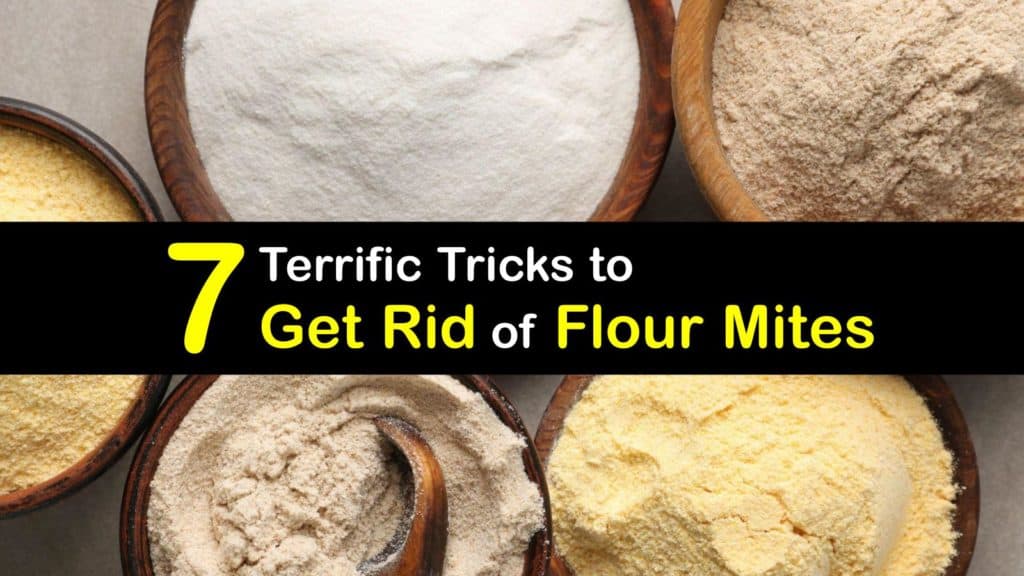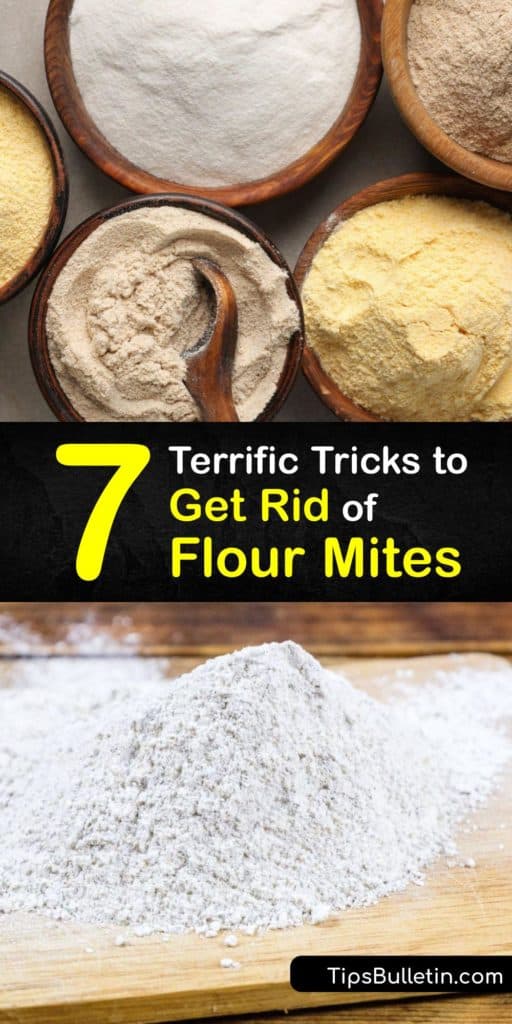If you’ve ever found little bugs in your flour before starting a baking project, you know that feeling of disgust. No one wants live and dead bugs, a larva or two, insect eggs, and even feces mixed with their pancakes. Before learning how to get rid of flour mites, you need to know a few things about your enemy.
There’s some confusion about how flour mites relate to other pests like weevils and flour beetles. Weevils are bigger and darker brown. Flour mites are smaller—nearly impossible to see with the naked eye—with a pale body and brown legs.
Look out for a brown, dust-like residue on dry foods like flour and cornmeal. You may also pick up a minty smell when you crush the powder between your fingers. The critters often enter your house on food or food packaging. They prefer dark, hot, humid conditions. A female mite lays up to 800 eggs during her life cycle of one month or less.

- Tips for Getting Rid of Grain Mites
- How to Get Rid of Flour Bugs by Cleaning Food Containers
- How to Get Rid of Flour Bugs by Freezing Food
- How to Get Rid of Flour Mites by Cleaning Your Pantry
- Vacuuming to Get Rid of Flour Mites
- How to Get Rid of Flour Bugs with Bay Leaves or Garlic Cloves
- Getting Rid of Grain Mites with Essential Oils
- How to Get Rid of Flour Bugs with Diatomaceous Earth
- What Happens If You Eat Flour Mites?
- How to Prevent a Flour Mite Infestation
Tips for Getting Rid of Grain Mites
No matter where you find bugs in the house, they are a problem. Identifying the insects is your first step to eliminating them. For example, different strategies are usually required to get rid of mites in bed and killing pantry bugs.
Whether you call them flour mites, flour bugs, or grain mites, the pests make an unpleasant find in your pantry.
Eating infected food may not cause any major health issues, but the bugs spread mold and reproduce rapidly. You do not want to let an infestation get out of hand.
How to Get Rid of Flour Bugs by Cleaning Food Containers
It’s a shame, but getting rid of grain mites involves throwing out any food that’s obviously infested. Use a plastic bag and an outside garbage can. Investigate your pantry with a magnifying glass to find any infested dry goods.
To get rid of pantry mites, wash the empty containers and their lids thoroughly in hot, soapy water. Hot water kills both mites and eggs on contact. Ensure the containers are completely dry before refilling them.

How to Get Rid of Flour Bugs by Freezing Food
As part of how to get rid of flour mites, freeze any food that you’re uncertain about, such as pantry items with no obvious infestation. Keep them below 0℉ for four to seven days. The cold temperatures kill mites, eggs, and larvae.
After the time has passed, consider sifting your flour or other dried goods. This method for getting rid of grain mites kills the pests, preventing them from reproducing, but does not make them disappear.
How to Get Rid of Flour Mites by Cleaning Your Pantry
Move food products to an outside garbage can, the freezer, or a safe location. Clean up any old spills on the counter or floor.
Although you could use an insecticide, pesticides are not safe to use in a food storage area. A flour mite infestation is not generally serious enough to warrant calling pest control. Instead, try making a DIY cleaner.
Make your own dust mite spray with these same ingredients to apply to furniture and bedding – be careful of using the bleach solution, though. You may want to stick to soap and water or vinegar and water so you don’t damage the material.
To kill weevils naturally and get rid of mites, apply the soapy water with a cloth, or spray the vinegar or bleach-based cleaner. Wipe the shelves clean with a rag or paper towel. When working with bleach, make sure to follow safety precautions like wearing gloves and goggles and opening a window.
Let the surface dry completely before returning food items. Using a hair dryer speeds up the process.
Vacuuming to Get Rid of Flour Mites
After wiping your pantry clean, use a vacuum to suck up any flour mites that are hiding. Run the vacuum over all the shelves and in cracks and crevices to get rid of rice weevils and other pantry pests that may lurk in the corners.
Dispose of the vacuum’s contents in a sealed bag in an outdoor garbage bin. Repeat the process of cleaning and vacuuming shelves as needed to eliminate the pests.
How to Get Rid of Flour Bugs with Bay Leaves or Garlic Cloves
Bay leaves repel a range of pests, including flour mites, cockroaches, weevils, moths, and rats. Some people say to use dried leaves, while others encourage the use of fresh ones. If you use fresh bay leaves, replace them when they dry out.
Tape the leaves to the outside of containers to help prevent a future infestation. Alternatively, place them right inside the canister—bay leaves do not significantly alter flavor.
Garlic cloves are also effective as a repellent for flour mites. However, avoid adding garlic to your baking ingredients.
Getting Rid of Grain Mites with Essential Oils
Several essential oils deter flour mites. Mix a spray to keep the pests away from your pantry items.
Shake the ingredients in a dark spray bottle. Squirt the mixture onto pantry shelves every few days to discourage flour mites.
Alternatively, soak cotton balls in tea tree oil, then place them around your pantry. Replace the cotton balls when they dry out or no longer release a strong tea tree smell.
How to Get Rid of Flour Bugs with Diatomaceous Earth
This white powder is composed of fossilized diatoms and kills several insect pests, including flour mites. The substance sticks to mites’ bodies, wearing away their protective outer coating and causing them to dehydrate.
Make sure to use food-grade diatomaceous earth. Consider wearing a respirator to avoid inhaling the stuff. Ensure that pantry shelves are free of flour before spreading the diatomaceous earth.
What Happens If You Eat Flour Mites?
Although it’s not pleasant to think about, consuming live or dead flour mites is unlikely to cause you any harm. Note that some people are allergic and have a reaction within minutes of eating infested food.
See a doctor immediately if you develop any of the following symptoms after consuming potentially infested grains or other dry foods.
Even though it is possible to eat a few flour mites without getting sick, it’s not recommended to do so long-term. Among other reasons, the pests spread mold between foods.
You also do not want to feed infested food to your pet. Animals sometimes experience an allergic reaction, diarrhea, inflammation of the intestines, and other unpleasant effects after eating mites.
How to Prevent a Flour Mite Infestation
A large part of how to get rid of flour bugs is preventing them from taking over. At the grocery store, ensure that food packages are intact and dry. Buying smaller bags of grains reduces the chances of food getting moldy or infested.
Freeze newly purchased grains for four to seven days to kill any mite eggs. Transfer dry foods to airtight containers to cut off flour mites’ food source. Store cat and dog food away from your pantry since pet food is subject to fewer regulations.
Avoid combining new and old grains in the same sealed container. Instead, finish the old food, then clean and dry the container well before refilling it. Clean your pantry regularly, tossing any old or expired food.
To discourage flour mites, keep your pantry well-lit with the humidity below 55 to 60%. You could install a humidifier, run a fan, or open windows.
Throwing out groceries is never fun. Just remind yourself, “I am doing this to keep my family safe and prevent an infestation.”
You have several other options for getting rid of flour bugs, including cleaning your pantry and storing dry foods in airtight plastic containers. Find out how to get rid of flour mites to enjoy pancakes and other goodies without the fear of finding tiny brown bugs.

If you found these tricks for eliminating flour mites helpful, please share these pest control tips with your friends on Pinterest and Facebook.